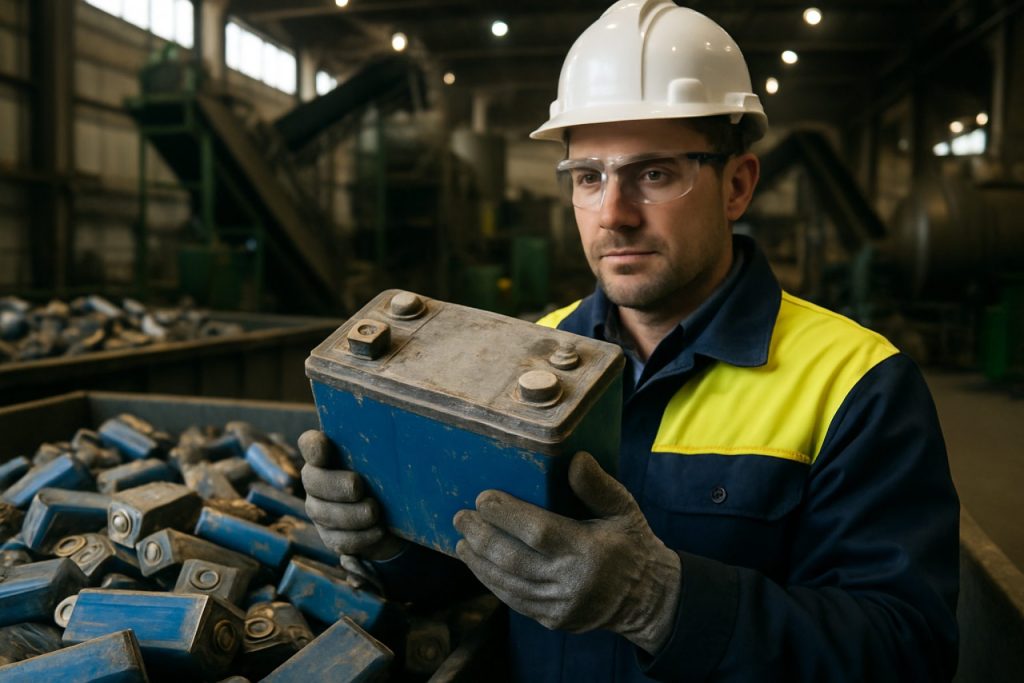
- Battery recycling is rapidly expanding worldwide, transforming waste into valuable resources like lithium, nickel, and cobalt.
- Asia-Pacific leads with strict battery reclamation policies and advanced recycling technology, while Europe enforces rigorous recycling rates through strong regulations.
- North America invests in AI-driven and water-based recycling processes, boosting clean energy ambitions and securing critical mineral supplies.
- Australia, India, and other emerging regions strengthen domestic recycling capacity, tightening producer responsibility and contributing to global sustainability.
- The global battery recycling market is projected to nearly double from $22.75 billion in 2024 to $41.66 billion by 2030, driving competition and innovation.
- Technical, legislative, and logistical challenges remain, but battery recycling is now a cornerstone of circular economy and clean energy independence.
Take a moment to imagine the world’s trash heaps—mountains of dead batteries from smartphones, power tools, and electric cars. Now, see those piles shimmering with potential. This isn’t science fiction. Across continents, a battery recycling revolution hums to life, transforming “waste” into the most coveted raw materials of the 21st century.
Asia-Pacific dominates this landscape. Precision factories in China, Japan, and South Korea run day and night, governed by some of the world’s toughest policies on battery reclamation. In China, it’s not enough to build new electric vehicles; manufacturers must also prove they can collect and recycle old battery packs, extracting vital lithium, nickel, and cobalt. This tight loop keeps resources flowing, prices stabilized, and environmental impact in check. Japan and South Korea, with their deep technological roots, double down on innovation—dismantling batteries with robotic arms and chemically teasing out every valuable atom.
Other regions are catching up, refusing to be left on the sidelines. Australia—the “quarry to the world”—now refines not just ore, but spent batteries at high purity, feeding its domestic demand while shipping recycled minerals worldwide. India, long challenged by electronic waste, has enforced strict producer-responsibility laws. As a result, every manufacturer is accountable for their product’s afterlife—a cultural and legislative pivot that echoes through city streets and countryside alike.
Europe sets the regulatory gold standard. Its sweeping Battery Regulation enforces minimum recycling rates, rewarding companies that reincorporate recovered materials and penalizing the laggards. The result: billions are poured into “gigafactories” intent on closing the material loop and reducing the continent’s reliance on imports. Automation and hydrometallurgical innovation blossom, with plants like Norway’s Hydrovolt recycling close to 96% of an EV battery’s ingredients for another turn on the energy wheel.
Meanwhile, North America surges ahead on the back of partnerships, cutting-edge processes, and strategic investments. Auto giants link arms with recyclers, racing to capture domestic supplies of critical minerals in a climate of global tensions. Companies like Redwood Materials and Li-Cycle deploy artificial intelligence and novel water-based chemistry to recover metals once written off as lost. Their results: batteries reborn with lower carbon footprints, and North American clean energy ambitions ever more attainable.
Outside these giants, regions like Latin America, the Middle East, and Africa quietly build capacity, leveraging their considerable mining reserves. Their success—or failure—will tilt future global power dynamics, as recycling becomes not only an environmental imperative, but a matter of national security.
The industry’s rapid growth is staggering: what stood at $22.75 billion in 2024 is projected to reach $41.66 billion by 2030. Competition turns fierce. Major players—Umicore, Glencore, Li-Cycle—battle for access to discarded batteries, while mergers and acquisitions redraw battle lines in this high-stakes pursuit of metallic wealth. Setting up even the smallest recycling plant requires capital and technical know-how; top-tier facilities bristle with automation, custom sorting lines, and AI-driven diagnostics.
Yet the hurdles are real. Dismantling batteries built for safety, not easy disassembly, demands a symphony of technology and experience. Costs are high, but so are the rewards: each recovered ton of lithium, cobalt, or nickel brings the world one step closer to clean energy independence.
As headlines trumpet the latest electric vehicle launch or solar milestone, the unsung heroes toil in the background—industrial chemists, policy-makers, and engineers—pushing the boundaries of what’s possible. Their efforts promise not just to recycle, but to redefine the very meaning of waste. In their hands, the afterlife of a battery becomes the prologue to a more sustainable story.
Key Takeaway: The race is on. Battery recycling, once an afterthought, has emerged as a cornerstone of the world’s energy transformation—reshaping economies, fueling innovation, and proving that, with vision and investment, yesterday’s refuse is tomorrow’s resource. Stay informed and power the future: explore how you can contribute to sustainability, or trace the latest breakthroughs at sites like IEA or Bloomberg.
What we throw away may just light the way forward.
The Hidden Empire of Battery Recycling: Untold Facts, Industry Secrets, and What It Means for You
The Battery Recycling Revolution: Beyond the Headlines
The world is on the cusp of a battery recycling transformation, but there’s more to the story than just resource recovery. Here, we expand on the fundamentals, dig into fresh insights, and answer the biggest questions about global battery recycling trends, technologies, and impact—empowering you with strategies, actionable tips, and a deeper understanding of this fast-growing industry.
—
Battery Recycling: Additional Facts and Insights
1. Environmental Impact & Carbon Footprint Reduction
– Recycling batteries significantly reduces mining demand, lowering land degradation and water use.
– According to the Argonne National Laboratory, recycled battery materials can reduce the carbon footprint of new lithium-ion cells by up to 30% compared to entirely virgin materials.
– Use of hydrometallurgical (“wet chemistry”) processes is expanding because they typically have lower emissions and energy requirements than pyrometallurgical (“smelting”) methods.
2. Industry Trends & Market Forecasts
– According to Fortune Business Insights, the global battery recycling market is forecasted to maintain a compound annual growth rate (CAGR) of over 10% between 2024 and 2030.
– Upcoming advances include “direct recycling,” which recovers entire cathode materials, needing less reprocessing and energy.
– Strategic partnerships are rising—Tesla is collaborating with Redwood Materials, and General Motors with Li-Cycle, underlining the shift towards a closed-loop battery supply chain.
3. Key Players: Reviews and Comparisons
– Umicore: European leader, known for closed-loop solutions and highly automated plants.
– Li-Cycle: North American innovator with novel water-based recovery techniques.
– Glencore: Leverages its mining/logistics network for vertical integration of recycling and refining processes.
Pros & Cons Overview
| Feature/Aspect | Pros | Cons |
|————————–|———————————————-|———————————————–|
| Closed-loop Recycling | Reduces import reliance; eco-friendly | Higher upfront costs |
| Hydrometallurgical Tech | Efficient chemical recovery; less pollution | Handling hazardous chemicals |
| Automation & AI | Boosts yield, safety, consistency | Significant capital investment required |
| Direct Recycling | Maintains material integrity | Still in research and early commercialization |
4. Security, Sustainability, and National Policy
– The European Union’s Battery Regulation (entered into force in 2023) mandates traceability, labeling, and digital “battery passports” that record a cell’s origin, chemistry, and recycling history.
– In the United States, the Department of Energy’s ReCell Center leads R&D for safe, high-yield recycling.
5. Controversies & Limitations
– Not all batteries are equally recyclable. Small devices (e.g., e-cigarettes, earbuds) are often glued shut, complicating disassembly and recovery.
– Safety remains a challenge—lithium-ion batteries can catch fire if punctured or shorted during recycling.
– Some nations lack robust e-waste infrastructure, raising risks of “informal” recycling, environmental pollution, or dumping in low-regulation regions.
6. Pricing, Features & Future Prospects
– Raw material price volatility (especially for cobalt, lithium, nickel) directly impacts the profitability of recycling plants.
– Emerging incentive schemes (like deposit-return systems) in Europe and North America are intended to boost return rates, making recycling more economically viable.
– Industry analysts from Bloomberg predict EV battery shortages by the late 2020s unless recycling ramps up to cover 20–30% of raw materials.
—
How-To: Recycling Batteries—Smart Steps Anyone Can Take
1. Find Local Drop-Off Points: Use certified collection centers; avoid tossing batteries in regular trash.
2. Sort Batteries: Keep lithium-ion (rechargeable) batteries separate from alkaline (single-use) ones.
3. Tape Terminals: Cover battery terminals with tape to prevent accidental short circuits.
4. Check Regulations: Familiarize yourself with local e-waste laws—certain devices require specialized handling.
5. Support Sustainable Brands: Choose electronics manufacturers with robust takeback and recycling programs.
—
Real-World Use Cases
– Automotive: Ford and SK Innovation are piloting “battery passports” for EV batteries, ensuring full traceability and responsible recycling.
– Consumer Electronics: Apple’s robot, Daisy, can dismantle over 200 iPhones per hour, extracting critical metals for reuse.
– Grid Storage: Retired EV batteries are repurposed for stationary storage, extending their useful life before final recycling.
—
Addressing Common Reader Questions
Q: How sustainable is battery recycling really?
A: When executed properly, battery recycling substantially lowers emissions, minimizes waste, and preserves finite mineral resources. However, effectiveness hinges on high collection rates and clean recycling processes.
Q: What happens to recycled battery materials?
A: They are typically reprocessed into fresh battery cells or used in related industries (e.g., steel production, electronics, ceramics).
Q: Can all types of batteries be recycled?
A: Most can, but the process differs by chemistry and design. Rechargeable lithium-ion batteries are the primary focus due to their high value and environmental impact.
—
Quick Tips for Consumers and Industry Leaders
– Always dispose of batteries through proper recycling programs.
– Monitor your local laws and incentives—many regions now offer rebates for battery returns.
– For businesses, partner with certified recyclers to ensure compliance and sustainability credentials.
– Stay updated on battery recycling advances via resources like the IEA and sector news portals.
—
The Bottom Line
The future of clean energy and sustainable technology depends on the evolution of battery recycling. From environmental benefits to advanced robotics and policy innovation, battery recycling is shaping a world where waste becomes a resource. Whether you’re a consumer, investor, or simply eco-curious, staying informed—and taking practical steps to join the movement—helps light the way to a greener tomorrow.



